
VO2 testing with Cardio Coach
Tue, May 5, 2009 - By Mike Muha
At last fall's CXC/NordicSkiRacer.com training camp, we had the opportunity to get VO2 tested. Since this VO2 testing is included at part of this year's CXC Lower Michigan Junior Development and Master Program, I thought you might want a few more details about what your getting into!
The test mice...er, skiers in this lab session included:
- Team NordicSkiRacer's Kelly Mikolajczyk, up from Ohio
- Cross Country Ski Headquarter's Larry Mergentime
- Team NordicSkiRacer captain and cheerleader Mike Muha
- Yuriy Gusev, CXC Executive Director and mad experimenter
We'll cover Kelly and Larry getting tested today, then go over my personal results and the results of an elite athlete in a second article.
Why get tested?
There are all sorts of reasons to get tested. First, how fit are you? A major component of measuring true fitness is determining VO2 max, or maximal oxygen uptake. Generally, fitter athletes have a higher VO2 max.
Second, a knowledgeable coach can look at the results and tell you how you need to spend you time training.
Most important, the testing determines your training intensity or heart rate zones. Knowing these zones lets you put a little science behind your training. For people who want to maximize the benefit of each workout, knowing what zone to train in is critical.
Getting tested: The pictures
Step 1. Get the equipment ready
We setup a running treadmill in my garage. Yuriy brought a Cardio Coach machine with face mask and connecting tube, a scale, a heart rate monitor, and cleaning gear.
Essentially, the Cardio Coach collects information from the air you exhale during the test and from the heart rate monitor.
Notice that the Cardio Coach does not measure lacate directly. To do so requires taking a blood sample every three minutes. Fortunately, the Cardio Coach actually collects much more information than a lacate test and is actually better at determining lacate and anaerobic threshold levels because of the almost continuous collection of data points.
Step 2. Weigh in
Some of the test results are divided by your weight. Also, you want to know what you weigh now so you can see if you increase or decease weight over the season.
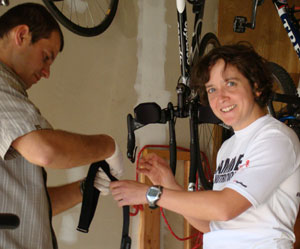 Step 3. Strap on a heart rate monitor
Step 3. Strap on a heart rate monitor
Kelly's getting ready to put on a Polar heart rate monitor that will be connected to the Cardio Coach testing machine.
Step 4. Setup and calibrate the Cardio Coach machine
Yuriy enters the age, height, weight and sex in the the Cardio Coach machine. The system needs the data to make calculations included in the report.
The machine is calibrated by drawing room air past the oxygen sensor. After the oxygen sensor has been calibrated to room air, the system detects baseline, or zero, flow.
Step 5. Put on the mask
The Cardio Coach machine needs to analyze all of the air exhaled during the test. The athlete needs to breath room air, then exhale only through the Cardio Coach. This is done by wearing a mask with one-way valves that's attached to the machine by a long tube. When your breath in, the valve opens to the room air. When you expel, the valve closes and the expired gases head down the tube to the machine.
The tight-fitting mask covers your nose and mouth. It's a slightly claustrophobic at first but you get used to it - it's easy to breath through the mask.
Then the tester attaches the tube to the mask. That tube is long - and you have to push your breath through. Breathing in feels normal; breathing out is harder. It does not feel natural.
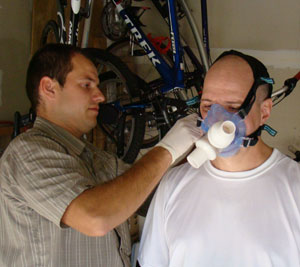 |
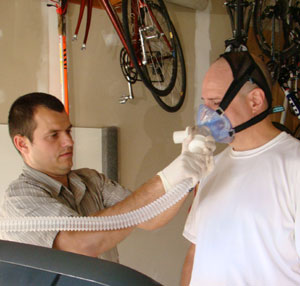 |
| Mask goes on face | Tube goes on mask |
Step 6. Let the testing begin!
The exercise test begins by turning on the treadmill at a very easy pace. The first three minutes are just you getting warmed up and the Cardio Coach getting some baseline data.
During the entire test, the Cardio Coach is measuring heart rate, oxygen consumption (VO2), carbon dioxide production (VCO2), and pulmonary ventilation (VE - the amount of air moved in and out of the lungs per minute). It also calculates various ratios of the above data.
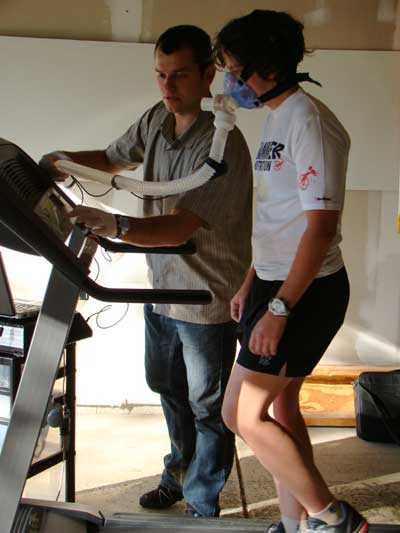
Kelly starting out at a walking pace
Step 7. The fun begins...
Every three minutes, Yuriy increases the speed and or incline of the the treadmill. It's no problem at first, but it gets harder, then harder, and harder still, then really hard, then really really hard, then "I can't take it anymore!"
Truly, by end of the test, the lactate is building mightily in your legs - they burn like crazy. Mentally, you try to be strong to stay on the treadmill an extra minute, then an extra fee seconds. The test is done when it's too hard to keep going and you jump to the sides of the treadmill. Yurey shuts down the treadmill so you can recover.
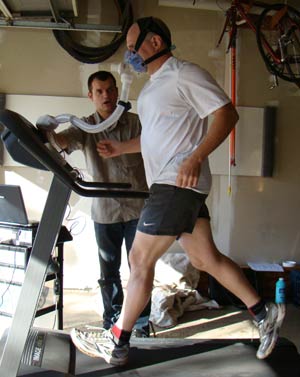 |
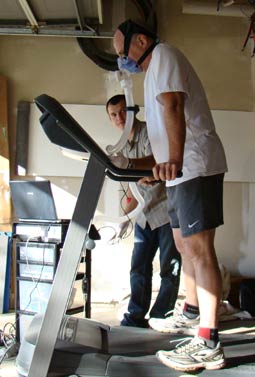 |
| Run Larry, run! | That's enough! Run no more... |
Step 8. Recovery phase
At the end of the exercise phase, you're breathing heavily and sweating profusely. But the Cardio Coach is still collecting data on your recovery. How fast does you heart rate recover? How fast do your VO2 and VCO2 levels normalize? After several minutes, you can finally disconnect from the machine.
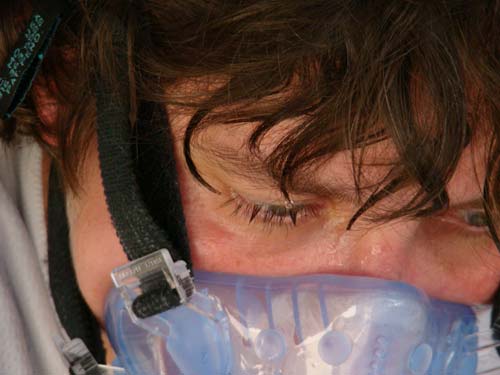
Kelly recovers from a very hard effort
Step 9. Results
The final step is to print the results and discuss them with the athlete.
The next article will show the results from my Cardio Coach test, plus results from an elite athlete.
